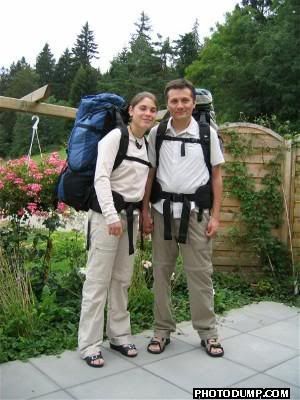Tuesday, April 26, 2005
Malaysia: The Peninsula
After nearly 4 months in Siam and Laos, time was ripe to move on to the Malay archipelago! All together a big cultural change: we left behind tonal languages and unreadable scripts to come back to roman characters and a more manageable language for us Europeans (Malay). Coming to those tropical equatorial regions, the climate also got noticeably damper, creating a almost unbearable sticky heat that, in the beginning, slowed down our minds and movements dramatically...
Georgetown
Georgetown, on Penang island, is the most obvious first stop coming from Thailand by bus. We stayed in the predominantly Chinese and Indian downtown. A few Malays, who live more in the suburbs, complete the ethnic mix found everywhere in West Malaysia. This created a rich diversity in food and cult places (mosques, buddhist and hindu temples, christian churches).
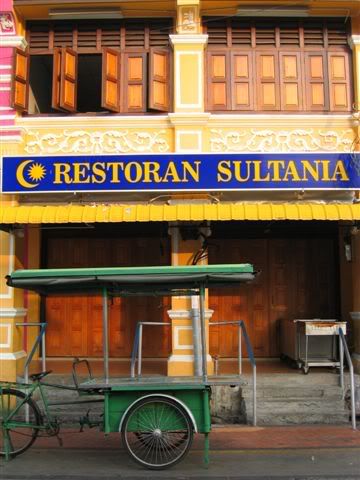
Our day began with a noodle soup at the chinese cafe on the corner of the road, and ended in Little India with tandoori chicken and a variety of curries and flat breads. The rest of the time was spent browsing the atmospheric streets lined with old shophouses. There, our path crossed Dr.Sun Yat Sen's again: in the house where he organised the uprising which eventually toppled the Qing dynasty in 1911, opening the way for modern China. We also did the almost mandatory pilgrimage to the very colourful Kek Lok Si temple, which, like most new Chinese edifices, looks better from a distance...
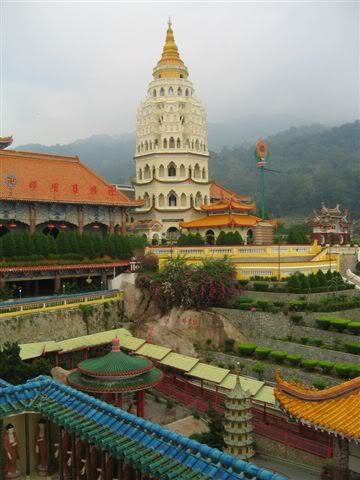
After hearing rave reviews from indian music vendors, we had to go to the local cinema to check out "Chandramukhi", a ghost story packed with dance, romance and action. It is the comeback movie of Super Star, a highly reverred actor who stayed away from the screen for 5 years, probably for a diet. Ever wondered how James Bond would look like if he was a psychic Bombai taxi driver?
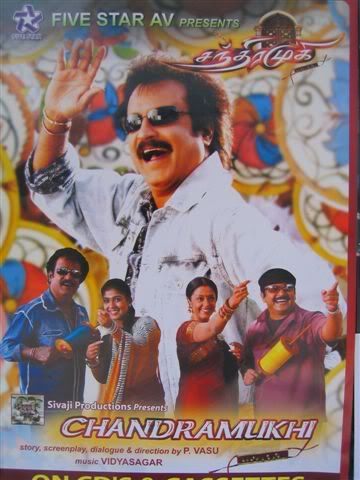
Kuala Kangsar
Kuala Kangsar, near the better known tin mining city of Ipoh, is the royal capital of the state of Perak. There, we got a first taste of malay small-town lifestyle: nasi lemak, a typical breakfast of white rice with dried salty fish sauce, egg and cucumber! The fairy tale moorish mosque and the royal palaces kept us busy for a day.
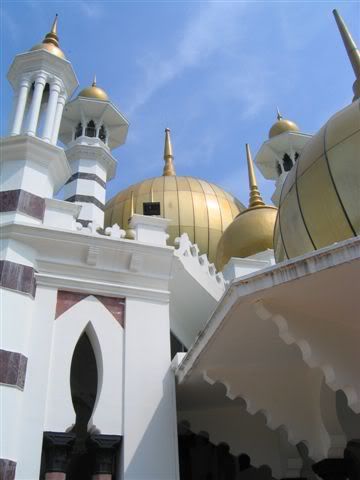
Kota Bahru and around
Kota Bahru, the capital of Kelantan, is the centre of Malay culture. It is one of the few cities in Malaysia with a Malay majority. Since the PAS (an islamic opposition party) took power in Kelantan in 1995, it has a reputation of an integrist state qualifying for Mr.Bush's "Axes of Evil". Of course, unlike 20 years ago, most women now wear the tudong (head scarf), a handful even covering their faces, and signs in the supermarkets direct men and women to different cashiers, but those are usually ignored by the locals. This probably denotes a more thorough practise of Islam, but the atmosphere remains extremely laid-back and friendly. Where else would a hostel owner invite you out for food and buy you breakfeast before putting you on the train?

During the heat of the the day, we usually slouched at one of the many street corner cafes, sipping lime juice or teh tarik, a sweet tea with condensed milk oxygenated by poring it back and forth between two recipients. Another way to escape the heat was to wander into the covered market, a colourful affair with a vegetable section on the ground floor and textile shops in the aisles upstairs.
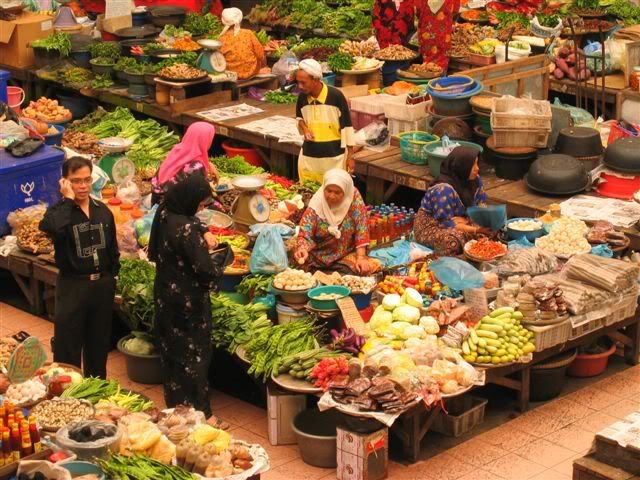
Twice a week, in the evening, the cultural centre organised free traditional shows, very popular with the locals. "Wayang kulit" (shadow puppets) on Wednesday and Malay theatre on Saturdays. For the shadow show, a live band plays while the puppeter handles his figures and entertains the public with funny improvisations over stories from the indian Ramayana, changing his voice for each character.
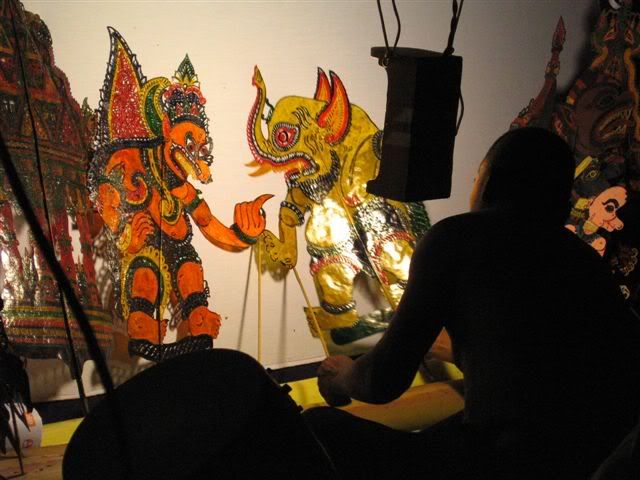
The theatre was initially a form of entertainment reserved for the royal family. It features some music and dances, but most of it is speaking. Difficult to follow for us, as most of the fun resides in puns and jokes in the local Malay dialect, which even the people from Kuala Lumpur don't understand... But the costumes were nice!

Every Friday morning, Kota Bahru's bird lovers congregate around a field for the bird singing contests. For a few hours, differences in social status and religion are forgotten and the most frequent question is "how's your bird doing?". We saw the red-whiskered bulbul competition, and the friendly vice-president of the club took time to explain us all about the birds and the events, introducing us to people and inviting us for tea. Each bird is judged on appearance, how often it sings and the sound of his voice. True fanatics can spend thousands of ringgits on cages and prices for contest winning birds can fetch a million or more...
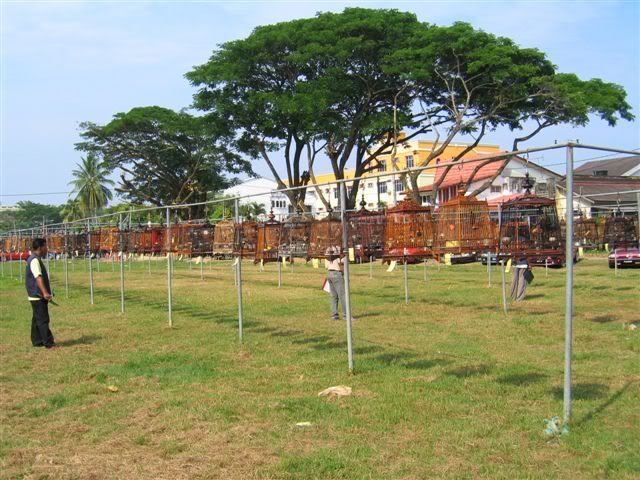
Around Kota Bahru, there are several malay kampungs where traditional crafts like kite-making and silversmiths are still well alive. In the late afternoon, children fly home-made kites in the rice fields.
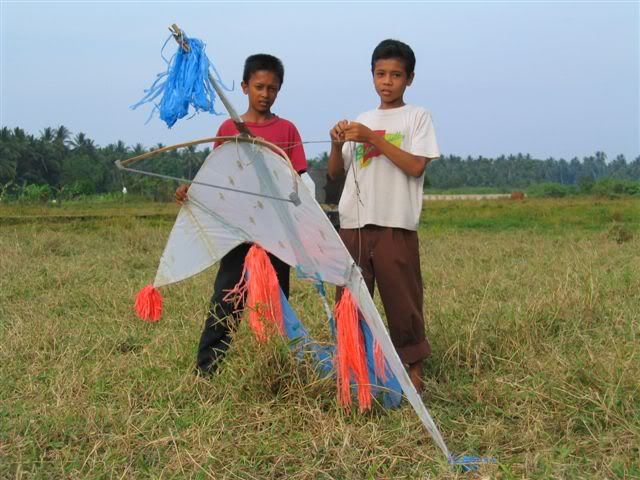
Taman Negara: The National Park
To go to the national park, we took the "Jungle Train" which runs through the centre of the peninsula. The only means of transportation for many folks living in the remote villages of the state of Pahang... The last leg of the journey was by boat up the picturesque Sungei Pahang, where we saw many kingfishers and water buffalos.
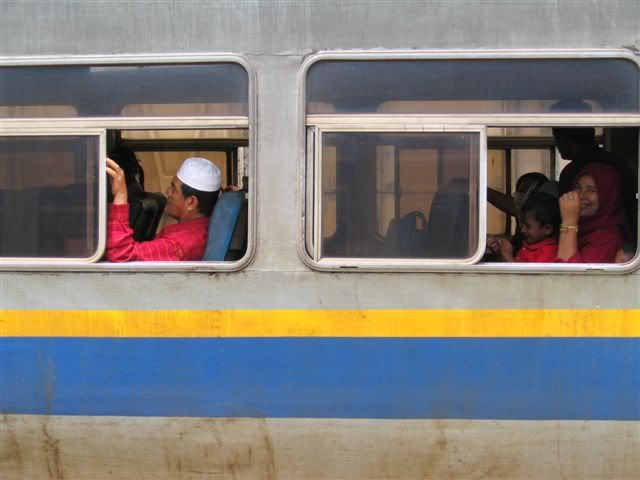
The national park protects the oldest rainforest in the world. We arrived during the flowering season, so the place was full of butterflies and fallen flowers from the canopy. During our treks along the trails, we also managed to spot some monkeys, squirrels, tortoises, monitor lizards, birds, creepers and crawlers, a tame fireback crested pheasant, an elusive mousedeer's rear, and had close encounters with leeches. A fancy caterpillar:
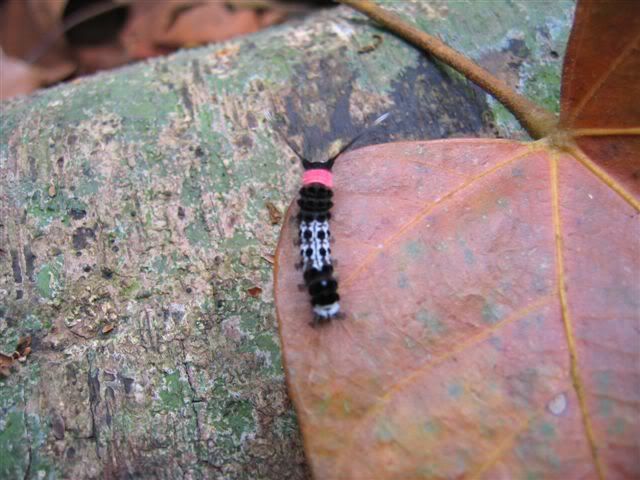
But most of the time, it was just deafening sounds (reminiscent of mobile phones, bicycle rings, chainsaws, buzzers and stranger stuff) amidst overwhelming green vegetation.

...the jungle where we almost got lost:
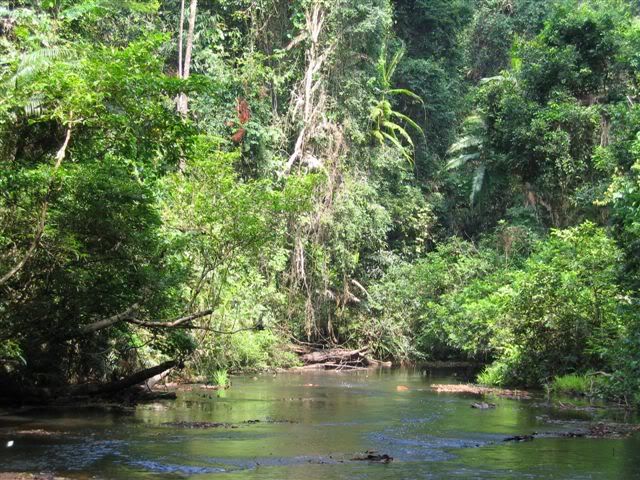
...back at the headquarters after 9 hours walk:
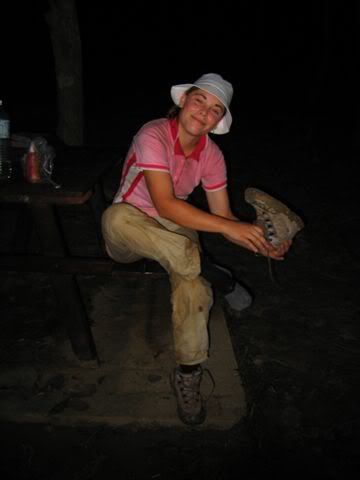
Port Dickson
After that, we went to meet relatives in Port Dickson. We had the pleasure to stay over the weekend with Auntie Victoria (Gilbert's mother's cousin) and her family. We chatted a lot, they brought us out for nice meals, introduced us to cousins and grand-children and left us their appartment at the beach. Auntie Jennifer and her husband came over from Kuala Lumpur to join the party. A very delightful way to recover from our jungle experience!
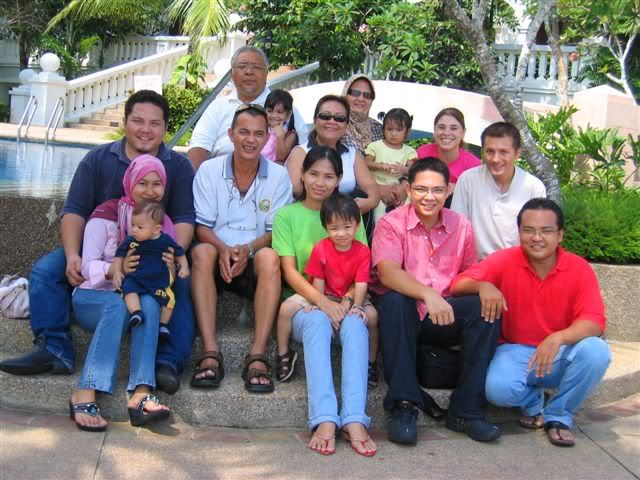
Melaka
Melaka, the oldest town in Malaysia, is just a few hours south of Port Dickson. We spent a couple of nights in the "Eastern Heritage", a very nice guesthouse in a typical chinese shophouse built in 1918.

In the 14th-18th centuries, Melaka was a bustling trading port between China and India. The malay court structure, and the bases of malay culture were defined there. In the 16th century the colonial powers took over (first the Portuguese, then the Dutch and finally the English). The town's decline started with the rise of Penang, and later Singapore. Remnants of this history are quite well preserved in the historical quarter (now painted red).
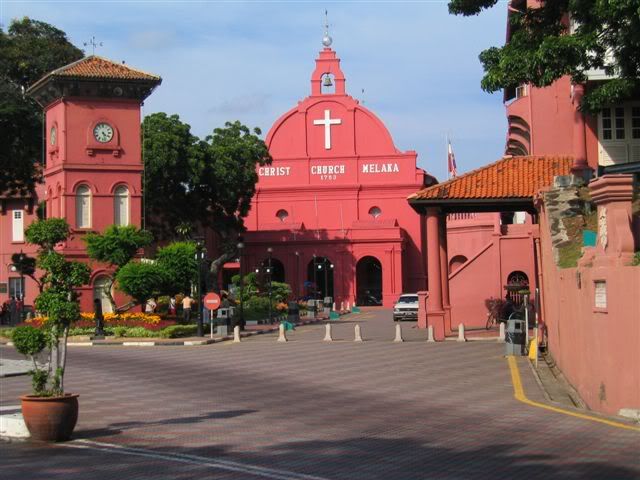
Further, Melaka's chinatown perfectly illustrates the Malay melting pot: a mosque with a chinese pagoda style minaret, corinthian columns and victorian furniture, some richly decorated 19th century houses of the malay/chinese baba-nonyas, churches and buddhist temples on the same street...
Seremban and Sri Menanti
After Melaka, we went back to Port Dickson for a night. The next day, Uncle Zainal and Auntie Victoria drove us to Seremban and Sri Menanti to see the Minangkabau houses and their distinctive horn shaped roofs.
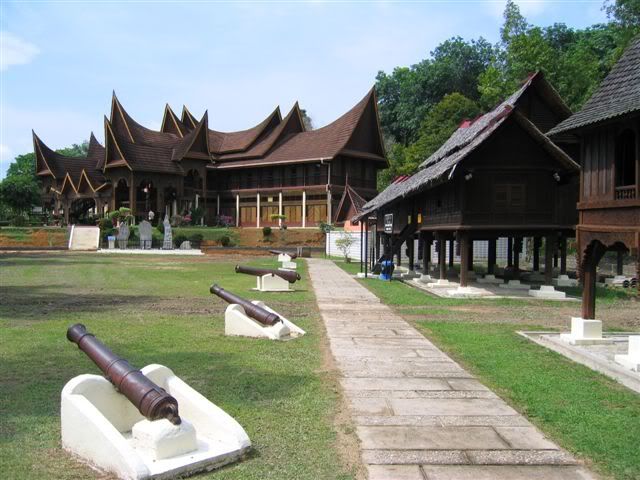
The Minangkabau people originally came from Sumatra. During a time of political instability, the sultans of the 9 states of today's Negeri Sembilan called them in as rulers and arbitrators.
Kuala Lumpur
In the late afternoon, they brought us to Putrajaya, the new administrative capital of Malaysia in the so-called "cyber corridor" south of Kuala Lumpur. The city has just been completed, and is slowly gaining momentum. The aim is to eventually implement a paperless administration. The Malaysians start to see the first signs of this politic: by the end of 2005, they are required to get their "MyKad", an electronic card containing all personal data (passeport information, bank account, health history)...
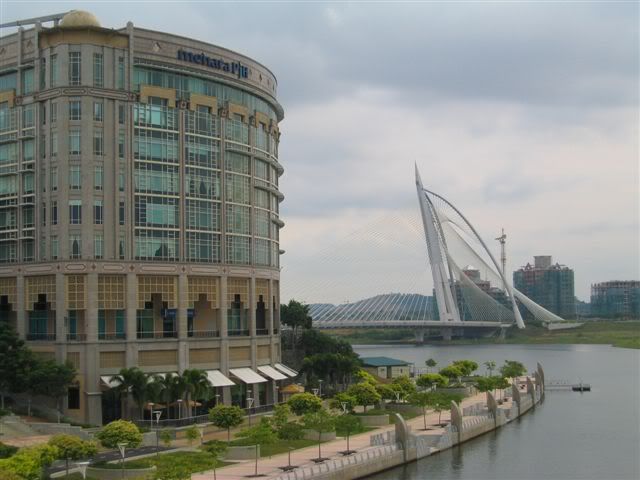
We spent the next days with Auntie Jennifer and Uncle Brabon's family in Petaling Jaya, a huge residential suburb of Kuala Lumpur. They spoilt us beyond belief: cooking marvellous eurasian and malay dinners, offering daily taxi service and accomodation in their daughter's flat, in a condo with swimming pool!
The city of Kuala Lumpur (KL for the locals) is the fastest growing capital of South-East Asia. Every couple of months, new buildings seem to appear in the skyline. Until now, this expansion was done without destroying too much of the city's character: the colonial quarters around Merdeka square are preserved, and, even though it has been cleaned up, Chinatown hasn't yet turned into the Disneyland it has become in Singapore...
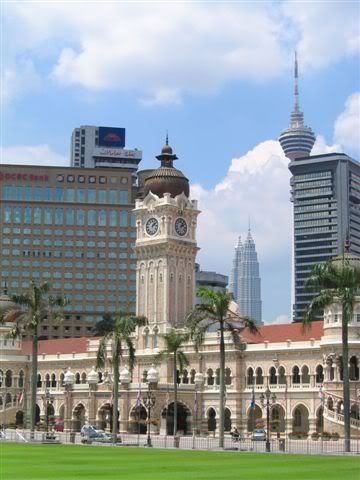
...Friday prayer at Masjid Jamek:
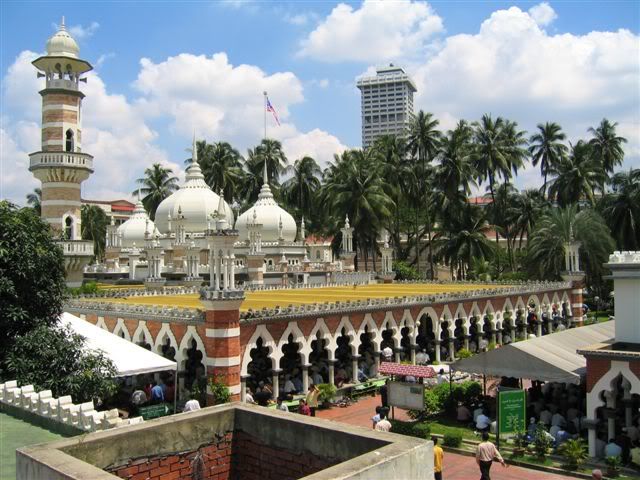
Shopping centres are omnipresent in KL. Locals often spend their free time in there, strolling between the food courts, cinemas, boutiques and supermarkets taking advantage of the free air-con! The futuristic mall entrance at Petronas twin towers:
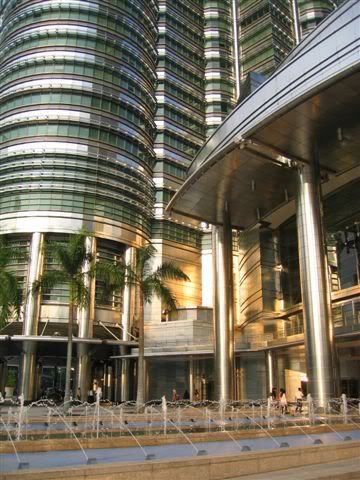
KL also has a few amazing gardens: the bird and butterfly parks, the orchid and hibiscus gardens... Welcome pieces of nature in the middle of a man-made environment!
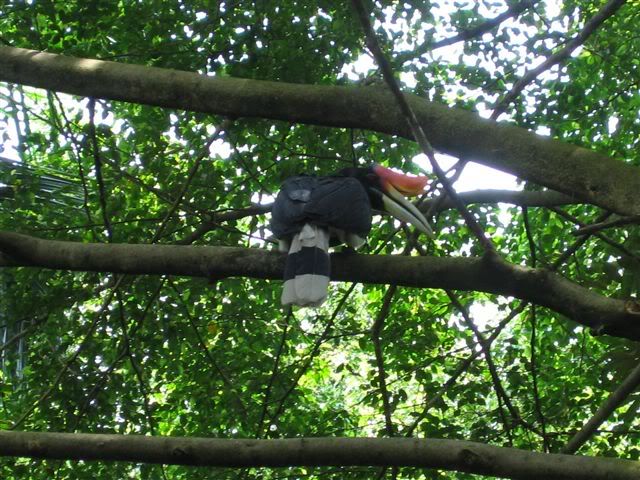
We enjoyed our last evening in KL, with Gilbert's "Bruneian" cousin E'wee, her brother Gabriel and her boyfriend around a steamboat dinner at Auntie Jenny's house.
Georgetown
Georgetown, on Penang island, is the most obvious first stop coming from Thailand by bus. We stayed in the predominantly Chinese and Indian downtown. A few Malays, who live more in the suburbs, complete the ethnic mix found everywhere in West Malaysia. This created a rich diversity in food and cult places (mosques, buddhist and hindu temples, christian churches).

Our day began with a noodle soup at the chinese cafe on the corner of the road, and ended in Little India with tandoori chicken and a variety of curries and flat breads. The rest of the time was spent browsing the atmospheric streets lined with old shophouses. There, our path crossed Dr.Sun Yat Sen's again: in the house where he organised the uprising which eventually toppled the Qing dynasty in 1911, opening the way for modern China. We also did the almost mandatory pilgrimage to the very colourful Kek Lok Si temple, which, like most new Chinese edifices, looks better from a distance...

After hearing rave reviews from indian music vendors, we had to go to the local cinema to check out "Chandramukhi", a ghost story packed with dance, romance and action. It is the comeback movie of Super Star, a highly reverred actor who stayed away from the screen for 5 years, probably for a diet. Ever wondered how James Bond would look like if he was a psychic Bombai taxi driver?

Kuala Kangsar
Kuala Kangsar, near the better known tin mining city of Ipoh, is the royal capital of the state of Perak. There, we got a first taste of malay small-town lifestyle: nasi lemak, a typical breakfast of white rice with dried salty fish sauce, egg and cucumber! The fairy tale moorish mosque and the royal palaces kept us busy for a day.

Kota Bahru and around
Kota Bahru, the capital of Kelantan, is the centre of Malay culture. It is one of the few cities in Malaysia with a Malay majority. Since the PAS (an islamic opposition party) took power in Kelantan in 1995, it has a reputation of an integrist state qualifying for Mr.Bush's "Axes of Evil". Of course, unlike 20 years ago, most women now wear the tudong (head scarf), a handful even covering their faces, and signs in the supermarkets direct men and women to different cashiers, but those are usually ignored by the locals. This probably denotes a more thorough practise of Islam, but the atmosphere remains extremely laid-back and friendly. Where else would a hostel owner invite you out for food and buy you breakfeast before putting you on the train?

During the heat of the the day, we usually slouched at one of the many street corner cafes, sipping lime juice or teh tarik, a sweet tea with condensed milk oxygenated by poring it back and forth between two recipients. Another way to escape the heat was to wander into the covered market, a colourful affair with a vegetable section on the ground floor and textile shops in the aisles upstairs.

Twice a week, in the evening, the cultural centre organised free traditional shows, very popular with the locals. "Wayang kulit" (shadow puppets) on Wednesday and Malay theatre on Saturdays. For the shadow show, a live band plays while the puppeter handles his figures and entertains the public with funny improvisations over stories from the indian Ramayana, changing his voice for each character.

The theatre was initially a form of entertainment reserved for the royal family. It features some music and dances, but most of it is speaking. Difficult to follow for us, as most of the fun resides in puns and jokes in the local Malay dialect, which even the people from Kuala Lumpur don't understand... But the costumes were nice!

Every Friday morning, Kota Bahru's bird lovers congregate around a field for the bird singing contests. For a few hours, differences in social status and religion are forgotten and the most frequent question is "how's your bird doing?". We saw the red-whiskered bulbul competition, and the friendly vice-president of the club took time to explain us all about the birds and the events, introducing us to people and inviting us for tea. Each bird is judged on appearance, how often it sings and the sound of his voice. True fanatics can spend thousands of ringgits on cages and prices for contest winning birds can fetch a million or more...

Around Kota Bahru, there are several malay kampungs where traditional crafts like kite-making and silversmiths are still well alive. In the late afternoon, children fly home-made kites in the rice fields.

Taman Negara: The National Park
To go to the national park, we took the "Jungle Train" which runs through the centre of the peninsula. The only means of transportation for many folks living in the remote villages of the state of Pahang... The last leg of the journey was by boat up the picturesque Sungei Pahang, where we saw many kingfishers and water buffalos.

The national park protects the oldest rainforest in the world. We arrived during the flowering season, so the place was full of butterflies and fallen flowers from the canopy. During our treks along the trails, we also managed to spot some monkeys, squirrels, tortoises, monitor lizards, birds, creepers and crawlers, a tame fireback crested pheasant, an elusive mousedeer's rear, and had close encounters with leeches. A fancy caterpillar:

But most of the time, it was just deafening sounds (reminiscent of mobile phones, bicycle rings, chainsaws, buzzers and stranger stuff) amidst overwhelming green vegetation.

...the jungle where we almost got lost:

...back at the headquarters after 9 hours walk:

Port Dickson
After that, we went to meet relatives in Port Dickson. We had the pleasure to stay over the weekend with Auntie Victoria (Gilbert's mother's cousin) and her family. We chatted a lot, they brought us out for nice meals, introduced us to cousins and grand-children and left us their appartment at the beach. Auntie Jennifer and her husband came over from Kuala Lumpur to join the party. A very delightful way to recover from our jungle experience!

Melaka
Melaka, the oldest town in Malaysia, is just a few hours south of Port Dickson. We spent a couple of nights in the "Eastern Heritage", a very nice guesthouse in a typical chinese shophouse built in 1918.

In the 14th-18th centuries, Melaka was a bustling trading port between China and India. The malay court structure, and the bases of malay culture were defined there. In the 16th century the colonial powers took over (first the Portuguese, then the Dutch and finally the English). The town's decline started with the rise of Penang, and later Singapore. Remnants of this history are quite well preserved in the historical quarter (now painted red).

Further, Melaka's chinatown perfectly illustrates the Malay melting pot: a mosque with a chinese pagoda style minaret, corinthian columns and victorian furniture, some richly decorated 19th century houses of the malay/chinese baba-nonyas, churches and buddhist temples on the same street...
Seremban and Sri Menanti
After Melaka, we went back to Port Dickson for a night. The next day, Uncle Zainal and Auntie Victoria drove us to Seremban and Sri Menanti to see the Minangkabau houses and their distinctive horn shaped roofs.

The Minangkabau people originally came from Sumatra. During a time of political instability, the sultans of the 9 states of today's Negeri Sembilan called them in as rulers and arbitrators.
Kuala Lumpur
In the late afternoon, they brought us to Putrajaya, the new administrative capital of Malaysia in the so-called "cyber corridor" south of Kuala Lumpur. The city has just been completed, and is slowly gaining momentum. The aim is to eventually implement a paperless administration. The Malaysians start to see the first signs of this politic: by the end of 2005, they are required to get their "MyKad", an electronic card containing all personal data (passeport information, bank account, health history)...

We spent the next days with Auntie Jennifer and Uncle Brabon's family in Petaling Jaya, a huge residential suburb of Kuala Lumpur. They spoilt us beyond belief: cooking marvellous eurasian and malay dinners, offering daily taxi service and accomodation in their daughter's flat, in a condo with swimming pool!
The city of Kuala Lumpur (KL for the locals) is the fastest growing capital of South-East Asia. Every couple of months, new buildings seem to appear in the skyline. Until now, this expansion was done without destroying too much of the city's character: the colonial quarters around Merdeka square are preserved, and, even though it has been cleaned up, Chinatown hasn't yet turned into the Disneyland it has become in Singapore...

...Friday prayer at Masjid Jamek:

Shopping centres are omnipresent in KL. Locals often spend their free time in there, strolling between the food courts, cinemas, boutiques and supermarkets taking advantage of the free air-con! The futuristic mall entrance at Petronas twin towers:

KL also has a few amazing gardens: the bird and butterfly parks, the orchid and hibiscus gardens... Welcome pieces of nature in the middle of a man-made environment!

We enjoyed our last evening in KL, with Gilbert's "Bruneian" cousin E'wee, her brother Gabriel and her boyfriend around a steamboat dinner at Auntie Jenny's house.
